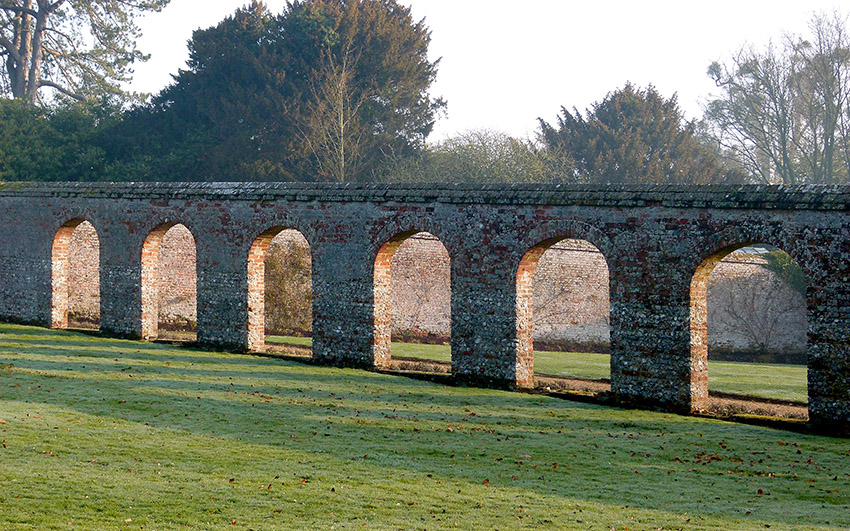
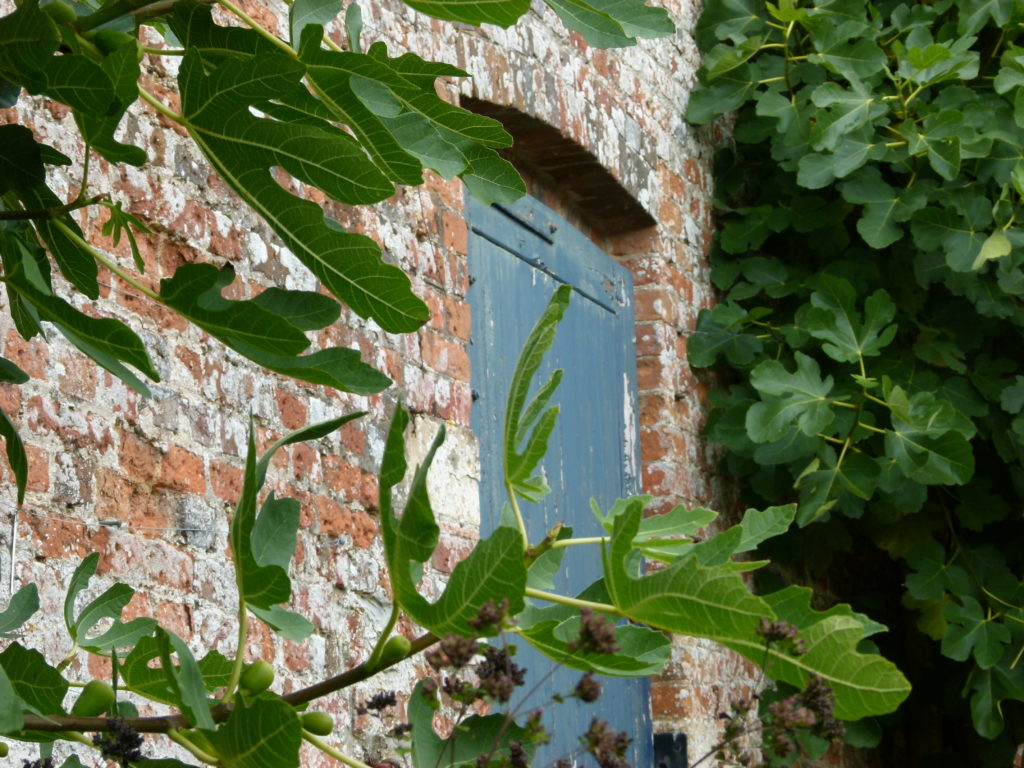
Walking down the hill away from the Castle, past a rather muddy pond (a favourite place of the dogs), you can then turn left into an old, brick walled, slightly forgotten, farm yard. Directly ahead there is an unobtrusive wooden door which gives no hint as to what lies behind it.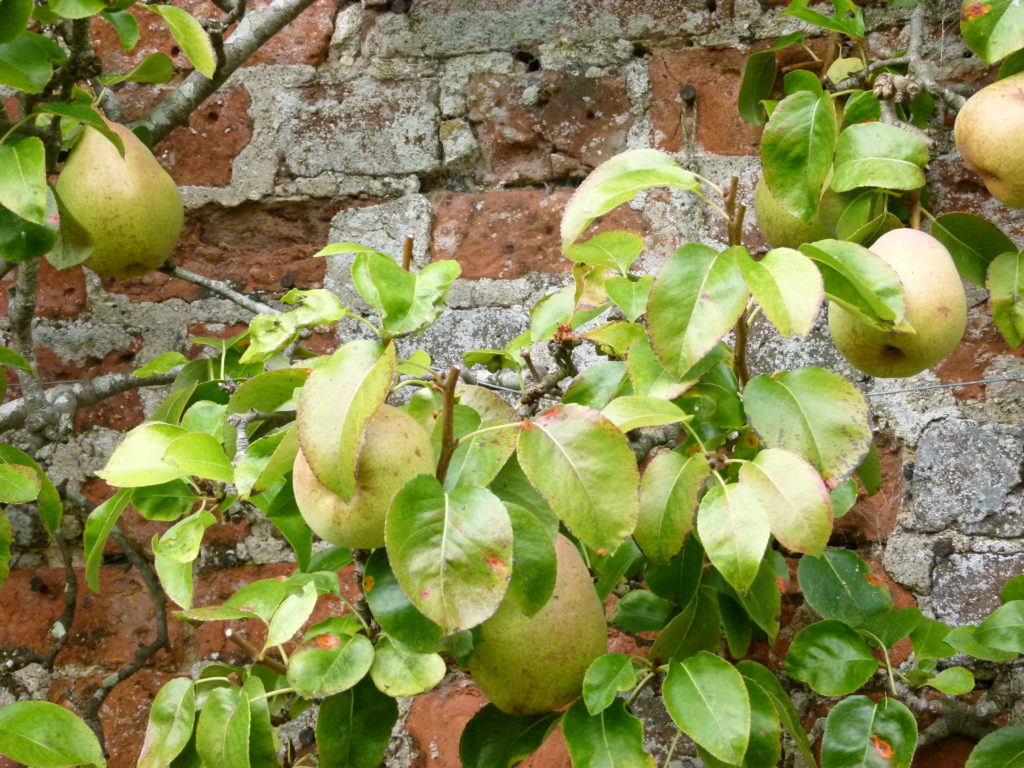
Push open the creaky heavy door and you step into another world. A huge expanse of what was once a hardworking, ordered kitchen garden full of texture and colour. To the left and right stretch mellowed brick walls some 10ft high, giving shelter from prevailing winds. A couple of hundred years ago bricks were the most prized building material, expensive and labour intensive to make, until the mass production of the later mid nineteenth century.
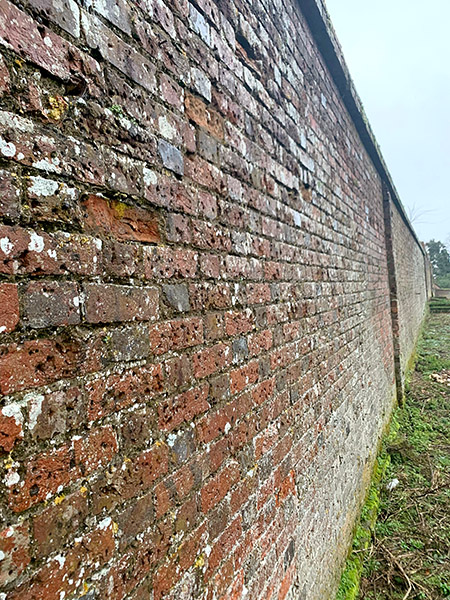 They retain the warmth of the sun whilst the lime mortar holds the nails that supported the wire against which espaliered trees could be trained. In fact, a tree belt was planted beyond the walls to act as a further windbreak to help give extra shelter. A few gates and doors of assorted shapes and sizes are set at various points in the walls to give access, whilst a frost gate at the centre of the lowest wall leads into an ancient orchard.
They retain the warmth of the sun whilst the lime mortar holds the nails that supported the wire against which espaliered trees could be trained. In fact, a tree belt was planted beyond the walls to act as a further windbreak to help give extra shelter. A few gates and doors of assorted shapes and sizes are set at various points in the walls to give access, whilst a frost gate at the centre of the lowest wall leads into an ancient orchard.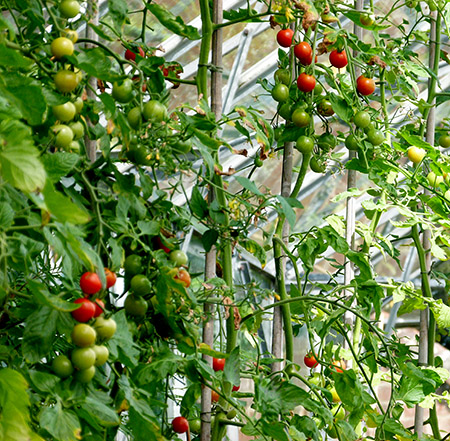
Old walled gardens gave protection from predators, created a sort of micro climate in which to grow more tender plants and tended to face south and west, often on sloping ground just as the one here does.
The original and oldest walled garden here lies much closer to the Castle and now welcomes visitors with mulberries, crab apples and flower beds. However, in 1771 Capability Brown marked out an area for a new walled garden, extending to some four acres, in his plan for the park here and it is this one which had lost its role. It had a central axis of paths dividing the garden into four quadrants, is adjacent to where there was the old dairy yard and hay ricks to ensure a ready supply of manure and had a series of pipes laid to allow for plenty of water.
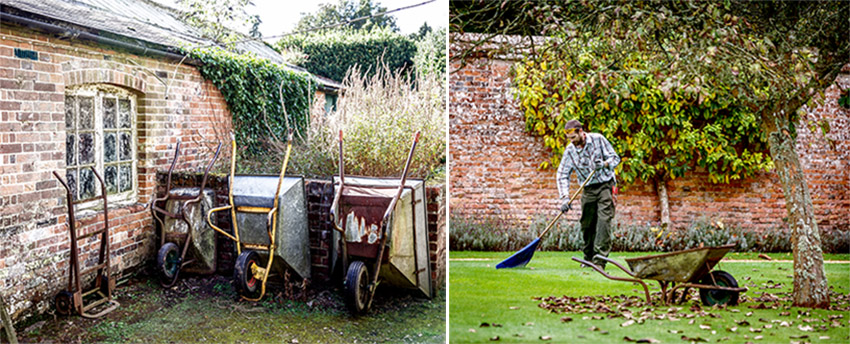
Within this space, the head gardener and his team used to grow outstanding vegetables and the best fruit. Crop rotations would have been diligently followed to prevent the build up of pests, legumes followed by alliums, roots, tubers followed by brassica. Behind the garden were outbuildings and storage sheds.
The First World War depended on huge quantities of imported food which continued to supply the UK in 1920’s. Thus the necessity for a walled garden began to wane and, apart from a brief resurgence during World War Two, continued to decline until often, as it was here, they were abandoned altogether.
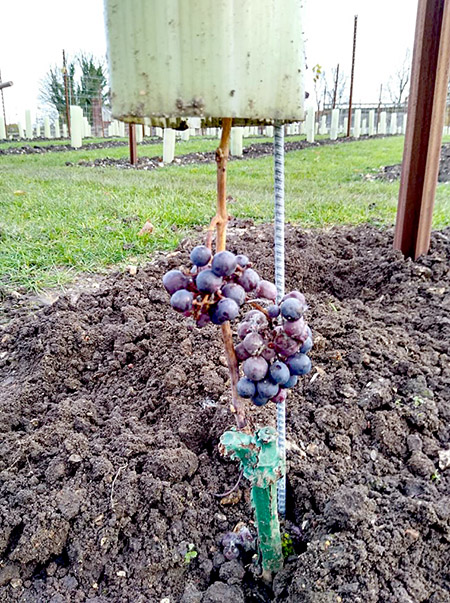 We have been looking for a new role for this space for some time whilst in the meantime quietly clearing the walls and turning the soil, working around the paths. It now has one: we have planted a vineyard. It has taken the last two years to test the soil, consider the temperatures and consult an expert. As a result, Chardonnay grapes are planted in the top two quadrants and Pinot Noir in the lower two so that, hopefully, we will be able to pick and make a delicious sparkling wine in years to come. Around the walls I can plant again espalier pear trees and roses, lavender underneath which we can then pick for the Highclere Castle Gin. All in all a spiritual journey.
We have been looking for a new role for this space for some time whilst in the meantime quietly clearing the walls and turning the soil, working around the paths. It now has one: we have planted a vineyard. It has taken the last two years to test the soil, consider the temperatures and consult an expert. As a result, Chardonnay grapes are planted in the top two quadrants and Pinot Noir in the lower two so that, hopefully, we will be able to pick and make a delicious sparkling wine in years to come. Around the walls I can plant again espalier pear trees and roses, lavender underneath which we can then pick for the Highclere Castle Gin. All in all a spiritual journey.
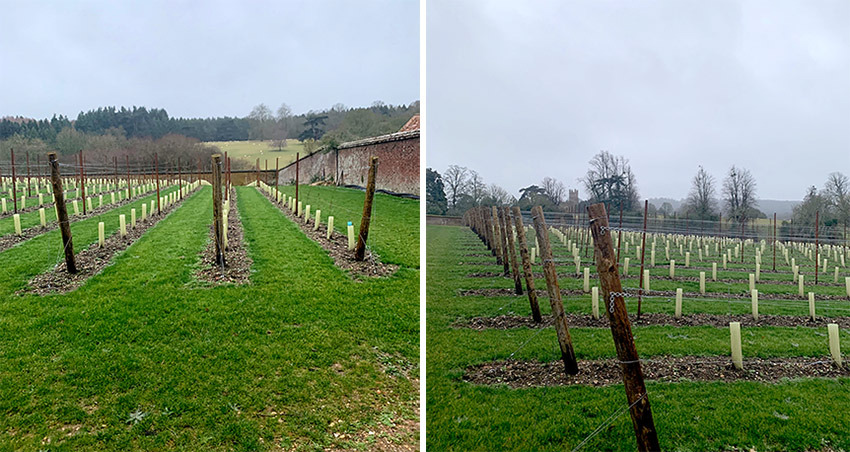
These are the first steps in what I hope will be a new life within these walls. I always loved Frances Hodgson Burnett’s book “The Secret Garden” and the magic of that hidden space: “It was the sweetest, most mysterious-looking place anyone could imagine” and I’m hoping that we are creating just such a different magical world here.








 Instagram
Instagram
Sadly, Highclere Castle gin isn’t available in my part of the US.
I love your stories about your home, and, by extension, how Britain’s upper class used to live. I hope one day to visit your home; I’m a Downton Abbey fan but have read about the previous Lord Carnarvon and his excavations.
I’ll most likely visit on a summer day in a few years, one of the number appreciating your family’s stewardship of the castle as it gives us an opportunity to visit a stately home adapting to changing society.
We have historical and stately homes that operate as museums in the states but none that I know of that’s still a family home. I appreciate that you share with us
I know that the roll-out for the gin is taking place state by state so hopefully it won’t be too long before you can sample it. The gardens are at their best in the Summer so it is a good time to visit us.
Actually, I believe, Biltmore House, is still considered a family home as many family members of George Vanderbilt still live on the property. It’s the closest thing we have in the United States to a castle!
Last summer, my husband and I and our 16 year old twins visited England (mainly London) for the first time. We had such a wonderful time that we have already planned another visit this coming summer. This time we will split our time between London and the countryside and Highclere Castle is top on our list of places we want to visit. My 16 year-old daughter has become quite the Downton Abbey connoisseur. We are so excited!
Dear Nan, The Highclere Castle Gin is available in New Hampshire (2 states from me) I had a friend pick it up for my husband who was very surprised at Christmas. Good luck!
Thank you!!
When we were at Highclere a couple summers back, children were playing, completely concealed in the line of old yew, I believe it is?, down in the walled garden, toward the south wall, if I remember my directions correctly. It was magical! Their laughter and voices completely evoked the Secret Garden and my husband and I laughed with them and found the whole experience so charming and delightful!
You are right! Walled gardens are truly magical. I remembering going out with my grandmother to dig spuds and pick apples in the walled garden behind the house where my father grew up in Ireland. As a small child it was such a fascination for me! And I, too, loved F.H.Burnett’s book (and the film with Shirley Temple!)
What a wonderful new adventure! And an excellent use of the garden. Best of luck!
The newer film adaptation of the book was made here at Highclere and starred Dame Maggie Smith
Hello Lady Carnarvon.
Loved the vision of the past gardens at the Castle. How resourceful to rework the space with a purpose again. Your writing is deliciously descriptive…I felt like I was walking the grounds myself today at Highclere.
Thank you for your delightful stories, updates and insights about life at Highclere, both past and present.
Your faithful follower from across the pond,
Jennifer Jones
Pelham, Alabama USA
You are very kind – thank you
Es most atrevit plantar vinya a aquestes terres taint el nort. Us desitjo molt exit.
Actually, due to climate change, most of the champagne houses in France have been buying up land in Southern England. From what I understand with every degree that the global temperature rises, the best area for wine growing moves 270 km to the north.
Your writing is so delish and descriptive. And the phots are much appreciated. Thanks for your time. I look forward to Mondays
Thank you
I love Monday mornings. A great cup of Tea (English Breakfast my Fave) and the best stories on the web, in my opinion. I love the old brick walls. They have stories in themselves of who and what they have hidden, kept safe or simply wouldn’t let go. If only they could talk. Thank you for sharing.
You are very kind – thank you.
Every time we visit Highclere we especially love walking down from the castle, through the meadow to this area…it is truly beautiful. The is a magical atmosphere and very peaceful in the woodland. The plants are always beautiful and interesting too. It must take so much work to maintain but so worth it to us visiting. Thank you.
The wildflower meadow is quite a lot of work – you can’t just leave it alone. We remove all the invasive, non-native plants which allows the native wildflowers to thrive. Each year at the end of the season it is mown and baled. Some years we collect the seeds and others we allow it to self-seed.
Love our Monday Family – I imagine all of us with our “cup of tea” – I was fortunate to walk in this meadow and take a picture with one of the Folly’s behind me last year.
Thank you so much
Lady Carnarvon,
One can perhaps imagine that once upon a time, hundreds of years ago, monks might have fostered a small vineyard in the area of the castle. Their monastery garden could also have been surrounded by warm brick walls to keep in the sunshine and add solitude to their prayers. Their care would have been similar to the care your vineyard will see in the next few years before you have a wonderful supply of grapes, both white and purple!
Thank you for a succulent addition to Highclere Castle’s offerings to visitors and guests. I look forward to placing an early order!
Martha G.
You may well be right, there certainly were vineyards here in Roman times.
WhAt a delightful read about the walled gardens. Great use of the land to plant grapes. So nice to learn another bit of the history of Highclere. All the best.
Jean
Thank you
Greetings from Fort Worth, Texas. Your photographs of the walled garden are absolutely magnificent. I can only imagine the peace and quiet reflections, including the hard work involved in bringing back the beauty and usefulness. Bending nature a bit can bring such rewards, with breathtaking results. I applaud your efforts with your private Garden of Eden.
Thank you
Dear Lady Carnarvon,
Peeking through mysterious closed doors allows great anticipation and imagination. I still feel like a child when looking at a door leading, perhaps, to an undiscovered adventure. How wonderful to transform the land from one purpose to another. The photos of the vineyard are beautiful, with the brick walls once again providing warmth and protection.
Will visitors be able to view these special places? I look forward to perhaps having a glass of delicious Highclere Chardonnay on a future visit. There is always something new to discover, inside and out, at your beautiful home. Congratulations!
Best regards,
Charlotte Merriam Cole
At the moment the vineyard is not open to the public, but watch this space . . .
Loved hearing about the work being done to bring rebirth to sections of the gardens at Highclere. I’ve had some health issues recently that have prevented me from gardening. Having recently retired, I’m looking forward to reworking my own garden beds. Though small they bring such joy when I look out my windows. Thank you for sharing on Monday’s. I look forward each week to your article. I hope to visit the Biltmore home here in the states. It currently is hosting the Downton Abbey exhibit.
Someday hope to visit Highclere as well. Thank you.
Gardening can give such pleasure, even if it is just a few herbs on a windowsill.
Good Morning Lady Carnarvon,
Thank you for making another Monday morning truly magical and intriguing for me. When you spoke of going beyond the walled area, The Secret Garden came to my mind.
It is wonderful to hear that you are bringing the area back to life. I wish you every success with the new vineyards and hope someday to be able to come and drink your wine.
Kindest regards,
Theresa
Wouldn’t that be wonderful?
I love your stories
Thank you. I am so fortunate to have such a rich source as Highclere.
Hello Lady Carvarnon
Was so nice to read your blog.
A moment if rest in our filled days….Thank you.
Thank you
Thanks for this,
Love that The Secret Garden was made at Highclere, I didn’t know this and will now take great pleasure in watching it again
KR
Josie
It was filmed in exactly the same place as they filmed the scenes which were supposedly in the Dower House gardens so Dame Maggie was quite familiar with the terrain!
Good idea!
Lady Carnarvon, I person never knows when they open a door what is there. The opening of your door is exciting. With your knowledge, Highclere too will have a magical area.
Thank you
Dear Lady Carnarvon,
Care in planning and the responsible management of resources: the stewardship of Highclere (the castle, its treasures, its people, the history, and the land) is in such excellent hands. I imagine Capability Brown would be so proud to have a garden come back to life within those walls these hundreds of years later. Now well rested, surely the land will do her share to help provide for the successful stewardship of Highclere into the future. What a lovely project. Cheers!
Thank you – I am sure you are right.
Mysterious doors, brick walls,secluded warm spots…….the imagination riots! Thank you for sharing!
Thank you so very much for sharing your life and lovely photos of Highclere and its grounds. Your stories always bring a calming smile to my day!
How kind – thank you
My Lady,
Thank you once again for brightening my Monday morning.
Holly
Sounds lovely! Planning on visiting England in late November. Are there still tours that time of the year ? Praying there are, cannot wait to visit!
While the Castle is closed at that time we do have some special tours in October and November so keep an eye on the website https://highclerecastleshop.co.uk/categories/admission-tickets
What a wonderful story about the walled garden. My wife and I visited Highclere this past summer and it was magnificent! I would have loved to have seen the walled garden. We also spent about 2 weeks at historic Launde Abbey east of Leicester and walked many times times through their walled garden. I was quite interested, based on your story, in the similarity between your garden and its history and the garden at Launde Abbey. Thanks so much for sharing!
Thank you.
Dear Lady Carnarvon,
Another wonderful story! Thank you for brightening my Monday morning. Or any day at that when I open your blog and read and re-read. It’s raining here and I sincerely hope that the storm will completely avoid your part of England; stay safe! Till next Monday. Best of Luck! Elizabeth
The worst of the storm has passed. We have had several trees down and were without power for most of yesterday.
My role in life is to care for a 160 acre homestead ranch in the Rocky Mountains of Montana, USA. The buildings were constructed only 80 years ago, all of logs taken from a nearby mountain and handworked. We face many challenges of upkeep, maintenance like painting that rotates to new sides of each building every summer, living with wildlife and working with fencing and land use to make our land welcoming to our wildlife neighbors. We are worlds away from you, yet your appreciation for family history, willingness to research and plan everything you do with a deep respect and appreciation of Place is an inspiration I cherish. I never imagined in working to preserve a ranch I would find so much in common with someone working to preserve a castle. I imagine at its root the work springs from the same kind of love.
I think we have more in common than you might think – juggling schedules, repairs, the changing seasons – and don’t forget ‘every man’s home is his castle’
Dear Lady Carnarvon,
Yet another wonderful read, I love walled gardens, there is something truly magical about them, good luck with your new venture.
Regards
Lorraine.xxx
Thank you
The Secret Garden by Burnett was my all time favorite adolescent tale of love set in the beauty of the secret garden, but I never knew the history of walled gardens. Thank you so much for bringing this alive for me once again at age 75. Your posts are one of my most treasured enjoyments in life.
You are kind – thank you.
Lady Carnarvon,
Once again you made Monday morning special for me. I always feel as if I’ve gained knowledge and an insight into the behind the scenes of Highclere. It is very interesting to me. It is so wonderful that you are not satisfied with the status quo…you are actively trying to go above and beyond. How proud and pleased the previous residents of Highclere would be!
I love the espalier trees! It makes so much sense to train the trees to be more’user friendly’. I have never seen this method put into practice, but it must be beautiful in the spring when the trees are in bloom. Do you know if any tree can be trained in this manner? It seems to me the trees would respond favorably since the structure used to support the plant would hold the warmth of the sunshine and release it to the plant. A win, win!
Hello, fellow readers!
Thank you for sharing with us and I pray you have a great week!
Until next Monday,
L. Sue Smith
Englewood, Florida
I know that fruit trees typically are trained in this way, but I don’t see why others could not – especially for hedgerows.
Wonderful to hear that you are following in the footsteps of your predecessors of the early 20th Century. (As beautifully described in your books about Almina and Catherine.) Enjoy!
Aaaahhh thank you!
Dear Lady Carnarvon: While all of your posts are entertaining and educational, I especially enjoy your posts about nature and about the environment around Highclere. They give me a sense of peace and calmness that living in a busy urban area cannot do. A quiet oasis that rejuvenates me for the days ahead. Thank you!
I am often thinking of how to knit urban and rural values together
Dear Lady Carnarvon,
This blog entry captured my imagination completely, as “The Secret a Garden” has been one of my absolute favorite books since I first read it at age 8 in 1961! I still re-read it occasionally!
What a wonderful use for your own secret garden – growing grapes to create wine!
I’m a relatively new subscriber to your delightful blog, having signed on after a November 2019 tour of the British Isles. It was a large group “highlights tour”and unfortunately did not include Highclere. It did whet my appetite for more, So I plan to return to the UK in 2021…and a visit to Highclere will certainly be on the itinerary!
Blessings to you and your family.
Thank you! Welcome to our Monday Club!
The first thing I thought as I started to read this was, “Oh, she has a “secret garden”! I think that’s something every little girl and grown woman has dreamed about since reading that book. You are so lucky, living the dream of so many!
Val -So. California
There is a door at the very bottom into an ancient orchard and that is where I feel I step into a magical world.
Due to global warming and if you get more rainfall and fog, please consider some warm climate vegetables and fruits for your gardens. If you have drier conditions starting then you may need some irrigation system. The soil at Highclere is probably substantially better than in SW FL and will have plenty of vital minerals and humus. From the pictures of your estate and what I saw in Downton Abbey, there is plenty of water and good drainage. It will take a substantial amount of work and could take up to 3 years before those gardens are up to production. Those walls look like they are structurally sound and should last many decades to come. I saw a green house in one of your earlier posts. Is it fully functional yet? If so you could grow tropical and sub-triopical fruits and vegetables in there such as Bok-choy, Chinese Water Chestnuts, snow peas, etc. May your family have all the good success that this endeavor deserves! Frank Chary
Thank you – I think like other farmers we use fertilisers with care and as in the past practise rotation. The walls in fact need some work but I thought to break down the work and budget into sections then it is all possible!
Will you laugh if I tell you that aside from the lovely story, I enjoyed your post just for the valid use of the word “espaliered”. I’m a bit of a vocabulary buff and I can’t recall ever having seen anyone use the word in normal conversation.
I don’t drink much but I’m very glad you found a good use for that area. With a home like yours, it just seems to me that all effort should be made to keep things properly used, and Mr. Brown’s diligent efforts and foresight deserve to be remembered and utilized.
I’m new to your blog here, having come from a late binge-watch of Downton Abbey, and I’ve enjoyed it quite a bit. Did you ever find out why the stone ‘plaques’ over the fireplace were left blank? Perhaps as space for new Ladies of the House?
Thank you – I rather like espaliered fruits of all sorts so I am glad to find you do too! I might go back into old photos and see if I can see any earlier clues about the the little blank “plaques”
Oh, thank you for asking about the blank shields! I have been wanting to ask for ages, but I always forget. My attention span is limited…..squirrel!!!! LOL
L. Sue Smith
Englewood, Florida
Dear Lady Carnarvon
Once again thank you for your beautiful evocative writing. Wishing you many years of lavender, mulberries and sparkling wine. Kindest regards.
Thank you!
good afternoon Lady Carnarvon –
You gave my heart a beautiful lift at the beginning of your blog – i was reminded of “the secret garden” and the first time i saw a blk and wht movie of it when i was about 9 yrs old. i wanted to go live there. alas, that did not happen – however I did get to visit the place in England in 1980 where was living and which inspired Ms Burnett. my first child was only about 1y6m and i took pictures – thank you for the beautiful memories.
shirley taylor – midwest city ok usa
Good Evening Lady Carnarvon,
Once again as I read your blog you transport me to the castle. I can feel the history seeping into my soul. The walled garden is yet another useful treasure discovered in the history of Highclere. I admire how you bring them all to working life again when you find them.
I finally read your books on Lady Almina and Lady Catherine and the feeling was much the same. Your gift of bringing the reader into the story itself makes your blog as much a joy to read as the books were. Thank you again, for the peek into your history and life.
Best regards,
Audrey Kuebodeaux
Thank you.
Dear Lady Carnarvon,
I loved reading all about your Secret Garden and I am excited about your using it as a vineyard. I think it is wonderful that that plot which was used so extensively in the past is getting a new life. It seems there is no end to your ingenuity when it comes to new projects around Highclere! It is always fun to read about the renovations that you plan. I am always amazed at you and your castle team. You are amazing and so appreciated!!!! Keep up the FANTASTIC work!
Happy Valentines Day (early),
Ann Catherine Flood
Thank you – it is a good team , everyone is kind ingenious and hardworking
Good evening. As part of the Monday Family, I so enjoyed the posting about the secret garden. It reminded me of my French great-aunt’s precise garden(the lady’s garden). We were allowed into it with her consent only. The kitchen garden involved actual work; at the time it wasn’t such a place of joy. Now, I love my plants and raised garden.
The storm has certainly affected many people, especially farmers. The loss of your trees is certainly going to require a new plan. Glad to know that power was restored quickly and no one was injured.
You mention mulberry in your post. Is this the variety that will support the silkworms? While I’m not fond of mulberry trees, there was an attempt to create “silk” farms many years ago. I can only imagine Highclere Silk as a popular fabric in the future if you decide to pursue that option. I collect scarves and would sign up for the waiting list!
Once again, I have a smile with my cup of tea and dreams of restoring the roses and pear trees to my fence(espalier planting). As a previous reply indicated, it’s rare to find someone who knows that term and is creating a garden. Congratulations with the vineyard planting; truly anticipating a glass of Highclere wine in the future.
I will view the movie: Dame Maggie Smith of “The Secret Garden” (one of the benefits of Amazon Prime). Thanks for listing it.
Have a pleasant week and safe one. Until next Monday when the Highclere Diaspora convenes again, enjoy.
Ida
I like eating mulberries!!
What an absolutely enchanting description of the gardens, as well as a wonderful explanation for those of us not as familiar with their purposes. As I was reading, I could just envision A Secret Garden- which is one of my very favorite books! I must say, I had a huge grin on my face as I read the last few lines! You have such a lovely way of describing various aspects of your castle, I truly look forward to reading your emails.
I always find it rather sad to see so many of those old gardens, especially the walled ones, abandoned and neglected. How wonderful that Highclere has found a way to repurpose yours.
Thank you for another beautiful blog entry. They always brighten my Monday!
We are happy to have found a new life for it
Dear Lady Carnavon,
Another wonderful blog! Love love reading about the castle also known as your home. Hoping to be there in 2021!
Have a wonderful week.
Lisa Cosgrove
Bolingbrook, IL
Thank you Lisa!
Good Evening from a gray dreary night in Kentucky. I enjoy so much reading your blog every Monday. I had the pleasure of visiting Highclere last April and hope to visit again soon. I missed the walled garden on the last visit. Is it open to the public? Are those Fig trees I see in the second photo? Oh how I love figs! Thanks for brightening my gray winter day!
It is not yet open but I think it would make a lovely special tour in the future!
The first thing that popped into my head when I saw the wall was “The Secret Garden.” My sisters and I read that many years ago and loved it. I used that book as a reading project for my own children one summer. We read the book a few chapters at a time and then watched 3 film versions. Thank you for the love story of your wall and the secrets behind it.
Hi
My goodness when you opened that walked garden who would have thought when you wrote about it, it would have provoked such a response. I’ve had the pleasure of working in a walled garden. On one occasion as I was working there was an erie silence, no bird song could be heard, it was a foreboding silence. When I went into the house for a cuppa, the news was breaking about the Twin Towers in America, a shiver shot through me, to this day and forever I will always recall that day .
I remember the book, Secret Garden! It fascinated me as a child. I’ll have to try and find it again. Thanks for mentioning it and the author’s name.
Dear Lady Carnarvon!
I am very happy to hear that you are all safe; all creatures big and small; I am sad for your trees…they do die standing. I was born and grew up in Prague, Bohemia, and your story brought me right back home. There are walled gardens at the Lesser Quarter under the Prague Castle; we would go to study there, or went for rendezvous. They were all my Enchanted gardens. Thank you again for your stories. Elizabeth
I am always amazed by the depth of knowledge those that care for our earth have! This was brought on by the order of the crop rotation and how much a science study it is! Thank you for your always interesting and informative writings Lady Carnavon!
Wishing many years of Chardonnay and Pinot Noir vines, and as always lavendar and mulberries!
Blessings,
Anita Cox
Lombardy ON Canada
Thank you!!
Good evening Lady Carnarvon,
Thank you very much for sharing your life and stories.
I visited Highclere and its gardens, for the first time, two years ago,
and I had the impression of discovering a treasure of pure beauty.
The castle and the landscapes were stunning and absolutely magnificent.
It was a sunny August morning and the gardens looked so peaceful and magical. I will never forget that special day and those beautiful views.
Maintaining a vineyard, cultivating grapes and producing wine is a hard work indeed, it needs constant efforts, cares and so much patience (as a wine producer I can assure you!) but it is deeply rewarding and such an exciting experience as well.
I wish you every success with your new project and I hope someday I will be able to come back and visit Highclere again.
Kindest regards and greetings from Italy
Loredana Poggi
Rovereto di Gavi
Thank you – there is something essentially peaceful about planting and growing..
Lady Carnarvon,
Every time I read your blog, I am more and more impressed! You have a lovely home and the constant improving is so interesting to me! The next time I get to England, I will certainly include Highclere in my roamings.
Thank you so much for your information and your pictures!
Lady Carnarvon,
Thank you so very much for sharing your wonderful home! Although I will probably never be able to visit in person reading your essays helps me to feel as though I am there!
How wonderfully committed and romantic your your story portrays with the development and history of you Secret Garden,I wish you great success and someday Hopefully I get to taste it’s success. So enjoy your stories or blog ,I learnt so much from them
As an Australian I just love English History and my visit to your home was one I never forget.
By the way the final film was outstanding ,the Royal Ball has me in happy tears
Best Wishes
Christopher Forsyth
Lady Carnarvon,
What interesting history in this beautiful garden. The labor you do to keep the Orchard ,creating the Vineyard and growing the amazing lavender is marvelous.
Thank you
This piece reminds me of “The Secret Garden” 🙂
Thank you for your delightful stories!
Bonjour Lady Carnarvon,
I am living in France, Alsace, near Strasbourg, and as a great fan of UK gardens and houses, I found your blog and it is just wonderful to read it. We visit regularly gardens in the UK and I hope to visit yours sometime. Walled gardens are magical. I visited also the one which inspired F.H.Burnett, it’s Great Maytham in Kent. I am already happy to read your next stories of your fantastic place. Thank you for this !
Dear Lady Carnarvon,
I truly love when I get the emails with your wonderfully written stories. I enjoy reading them so much. I’ve never been overseas, not sure that I ever will be… so I watch a lot of the documentaries about other places.
I love getting your emails with your first hand experience of living in a castle. and how real life is there.
Thank you so much for the opportunity to learn more about how it is to live in such a place.
Sincerely,
Dawn Hawley
Alabama, USA
Thank you! I have read all my life for similar reasons – a glimpse into other places and lives
I love the idea of a small winery! Hyper-local. Some of my favorite local wineries in my home state of Maryland are quite small, making their wine that much more special. May all that needs to cooperate for a successful vineyard do so!
Cheers,
Mallory
Thank you – I agree that small and local is the better way to be.